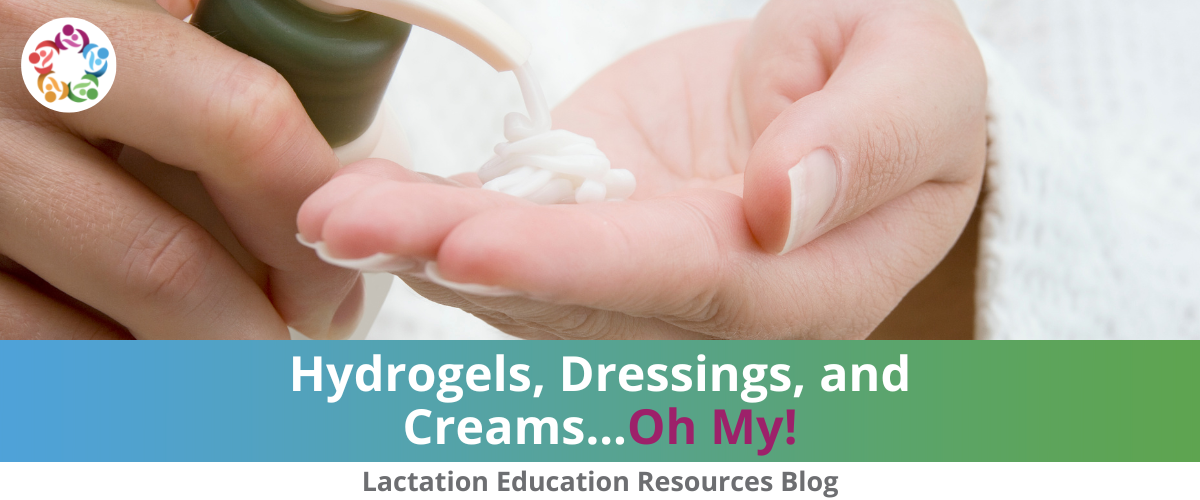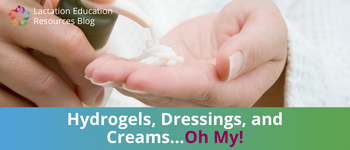

Well-meaning friends tuck them into baby shower gift bags. Online new-parent forums are filled with advice about which ones work best. And by the time you see a client with nipple pain, they’re probably already using one.
Nipple creams and gel dressings – they come in countless forms and formulas, over-the-counter to prescription, pharmaceutical to herbal, traditional to new technology.
Unfortunately, misinformation about their use is just as common. And misuse can be worse than ineffective–it can actually make pain worse, lead to infection, or delay identification of the underlying problem.
Below, we’ll discuss the Do’s and Don’ts of recommending nipple creams and gels, based on the most current scientific evidence.
Let’s start with the Dont's.
The Don’ts of Nipple Creams & Gels
Research suggests that up to 97 percent of lactating parents experience nipple pain, and more than half develop visible wounds. As a lactation care professional, easing that pain is a high priority! But when you’re offering nipple creams and gels, don’t do the following:
Don’t use gels and creams preventatively. New parents often assume they should start using some kind of cream as soon as they start breast/chestfeeding their baby, just in case they develop pain. But this is a bad idea for several reasons. A client may be allergic to an ingredient in the cream, or their baby may have a reaction to it. Counsel clients to avoid using products unless there is a clear need.
DON’T use gels and creams in place of determining the root cause. If you don’t know why a client is having nipple pain, it can’t hurt to try a cream, right? Wrong. A cream can mask the underlying cause or even create additional problems. It’s critical to determine why the pain is occurring. Once you have done that, a cream or gel dressing can be a valuable tool in the healing process.
DON’T neglect clear instructions. While many creams should only be used twice a day, parents mistakenly apply them after every feeding. Some should be wiped off before breast/chestfeeding, while others don’t need to be. When you recommend a nipple cream or gel dressing, make sure you leave your client with a clear, written plan for when and how to apply it and what results they should expect.
DON’T use ingredients you don’t need. Compounded nipple creams are a common choice. They’re made by a pharmacist or with OTC products and contain multiple active ingredients–which sounds good, because they cover all the bases, right? Not necessarily. Using medications your client doesn’t need can lead to problems. Critically evaluate the situation and recommend only what is needed, not all the standard ingredients.
DON’T assume your client will know when to discontinue use. Once they begin using a nipple cream, many parents continue to use it for months–even after the product has expired. Make sure your care plan includes info on how long to use the product, and when to stop.
The Do’s of Nipple Creams & Gels
Now that we’ve covered the Don’ts, what should you do to provide evidence-based recommendations about nipple creams and gels for a client with nipple pain and/or damage?
DO find and fix the cause. Whether your client needs help with latch and positioning, their baby has tethered oral tissues, or some other issue is at play, simply using a cream or gel without understanding the reason for the pain will not be successful. Carefully and systematically evaluating each member of the dyad as well as a nursing session is key.
DO heal visible wounds. Gel dressings are the treatment of choice for healing open wounds. Ensure your client knows how to apply them and follow up to make sure wounds are healing.
DO use human milk first. Readily accessible and with effectiveness backed by research, your client’s own expressed milk may offer the best healing option. It can also be used in combination with other products, if needed.
DO consider non-pharmaceutical options. Silverettes, breast/chest shells, and low-level laser therapy are all powerful tools to consider.
DO follow up carefully! Helping a client solve nipple pain and damage often takes time. Whenever you recommend a nipple cream or gel dressing, follow up to ensure that the underlying problem that led to the pain has been identified and resolved.
One More Do: Do consider learning more by enrolling in our course
Use of Gel Dressings and Nipple Creams During Lactation. Instructor Leslie Southard, PharmD, BCACP, CBS brings a wealth of knowledge to this subject as a Board Certified ambulatory care pharmacist, Certified Breastfeeding Specialist, and labor and postpartum doula with a career focus on medication use during lactation. She covers in great detail a wide range of specific products on the market today (pharmaceutical, OTC, and herbal creams as well as many types of gel dressings), including research-based information on safety, efficacy, and recommendations.
Looking for CERPs? This course covers Pharmacology and Toxicology,Pathology, and Clinical Skills in the IBLCE Detailed Content Outline.
Explore the Course